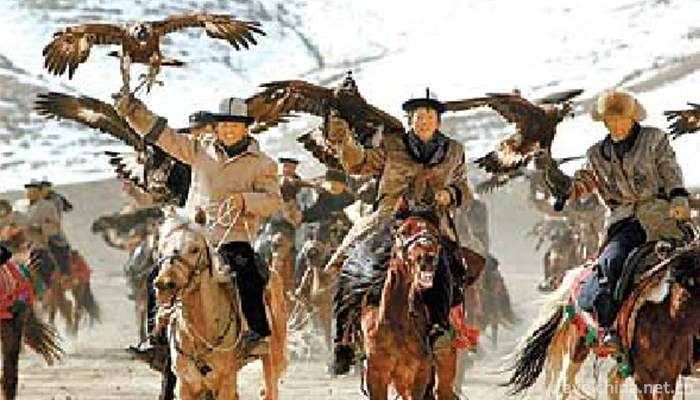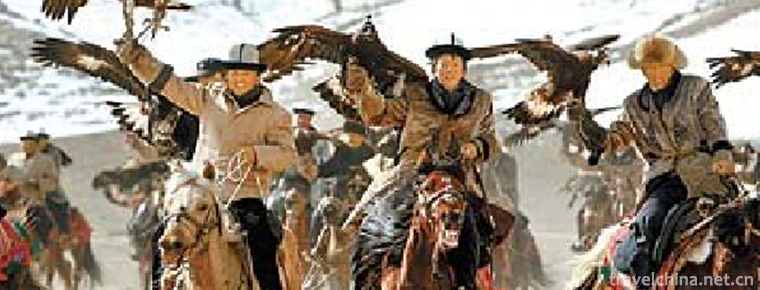Kirgiz hawk taming custom
Kirgiz hawk taming custom
Originating in the East, the Falcon has a history of 4000 years. The custom of taming Eagles has been handed down orally without any written records. However, the Kirgiz people have kept the saying of taming Eagles for thousands of years. Falcons and hunting require great patience and energy, and no one wants to learn now. Eagles are fierce and unruly. Generally, they are fed and domesticated from the young eagles. But it is time-consuming and laborious. The trained eagle is too weak and lacks the attack power of the wild eagle. The real Eagle tamer catches and domesticates the adult Eagle directly. The difficulty is great, but once domesticated, the power doubles. Hundreds of falcons domesticated by themselves. Whenever hunting in winter, Kirgiz falcons cross horses with their hands, and gallop among mountains, forests and grasslands with their fierce falcons, they will reap something.
On May 23, 2011, Kirgiz hawk taming custom was approved by the State Council and listed in the third batch of national intangible cultural heritage list.
Custom introduction
June 2011 was selected as the third batch of national intangible cultural heritage list.
Number: 1218 Item Number: X-143 Declaration Area or Unit: Aheqi County, Xinjiang Uygur Autonomous Region
Kirgiz people have a close relationship with eagles. For thousands of years, their place of residence has been called "the land of falcons". In the years without guns, people tamed fierce eagles to hunt for themselves, and a good Falcon could feed a family. In the past, the price of an eagle was higher than the dowry of a Kirgiz girl. Raising eagles is also a luxury. A hawk-taming license costs 500 yuan, not to mention that this fellow can eat two kilograms of meat per meal, but it has to be fresh.
There was a time when Hawking was forbidden by the state to protect wildlife. Two years later, the ban was lifted because it was understood that hawk-taming was a unique folk custom of Kirgiz people for thousands of years, which needed protection and inheritance. Kirgiz and eagles abide by an agreement: they never nest this precious raptor, always quietly take away the most desirable Eagle home for domestication.
A good Eagle tamer needs three qualities: hobby, stability and strength. All three are indispensable.
Falcon Township
Aheqi County, located in the hinterland of the southern vein of the Tianshan Mountains in Western Xinjiang, is located in the alpine mountainous area. The Southern vein of the northern Tianshan Mountains and the southern Karatek Mountains are sandwiched with a narrow Toshkent Valley. In the foothills of valleys and mountains, there are plenty of water and grass in summer and autumn, which provide enough food for falcons, such as rabbits, mice and even foxes. The Kirgiz and their Falcons have found their paradise here.
Since ancient times, Falcons have been a member of the family of Kirgiz herdsmen. After the falcons were listed as second-class protected animals in China, they have registered their "household registration" for their falcons.
Sumutashi Township in Aheqi County is named "Falcon Township" by the Ministry of Culture of China. There are more than 400 herdsmen in this town, almost all of them will domesticate and hunt falcons. The herdsmen hope to continue domesticating falcons, but they do not want to break the law.
The Kirgiz hawk taming artists in Aheqi County, Xinjiang, have learned a lot about hawking, boiling, taming, releasing, playing with hawks and smuggling of falcons, which has lasted for seven years. Aheqi County is a place where Kirgiz people live together. Kirgiz people account for nearly 80 percent. Since the original way of Falcon domestication is still completely preserved here, it is also known as the "home of falcons" in China, and the local Kirgiz are also known as the "King of Eagles". Origin of Falcon Country. "In 1991, Andrew, a British hawk trainer, visited Sumatash, Ahoc County, to study hawk training skills. He said that in the world, the home of the Falcon is Sumatash, Ahoc County. And more than 400 herdsmen in Sumatashi, who domesticate eagles and hunt, are the true home of eagles. Every winter, Hundreds of falcons gather in Sumatash, holding days of Falcon hunting competitions, which are more interesting and exciting than watching bullfighting in Spain.


-
1.Tea horse ancient road
Tea-horse ancient road refers to the folk international trade
Time 2018-10-17 -
2.Martial Art
Wushu is a technology inherited from ancient military wars. Martial arts can strengthen the body and defend the enemy
Time 2018-11-13 -
3.Weihai Liugong Island Scenic Area
WeihLiugong Island is located in Weihai Bay, the easternmost part of Shandong Peninsula. It has rich and unique cultural landscape, including the Warring States site dating back thousands of years
Time 2018-12-08 -
4.Yellow River Estuary Ecotourism Area
The Yellow River Estuary Ecotourism Area is located in the Yellow River estuary area of Dongying City, Shandong Province. It has unique ecotourism resources of the Yellow River Delta
Time 2019-01-18 -
5.Museum of Xinjiang Uygur Autonomous Region
The Museum of Xinjiang Uygur Autonomous Region, located at No. 132 Northwest Road, Urumqi City, is a provincial comprehensive geographic museum.
Time 2019-02-25 -
6.Zhoucun Ancient Mall
Zhoucun Ancient Mall, also known as Street, is located in Zhoucun District, Zibo City, Shandong Province. The main road of Shandong Province, Jiqing Expressway
Time 2019-03-20 -
7.Iron flower
Tiehua is a kind of fireworks which spread in the folk traditions of Henan and Jin Dynasties. It has a long history which can be traced back to the Spring and Autumn Period and the Warring States Peri
Time 2019-04-23 -
8.Lusheng music
Lusheng is one of the core musical instruments in Miao traditional music culture. In the long history of Miao music practice, its cultural function is not limited to universal musical instruments, bec
Time 2019-05-15 -
9.dough figurine
Noodles, also known as face sculptures, models and flowers, are simple but highly artistic Chinese folk crafts. As early as the Han Dynasty, Chinese face sculpture art has been written down. It uses f
Time 2019-06-05 -
10.Pumi rubbing
Pumi nationality rubbing "rubbing consultation" is Pumi language, "rubbing" means dancing, "rubbing" means dancing, that is, dancing. When dancing, the leader strikes the
Time 2019-06-09 -
11.Longhua Baxian Mountain Giant Buddha
Longhua Baxian Mountain Giant Buddha is located in Baxian, Longhua Town, Pingshan County, Yibin City, Sichuan Province. Since the Bamiyan Buddha in Afghanistan was bombed by the Taliban
Time 2020-10-16 -
12.Panzhihua before Sui Dynasty
Archaeological discoveries have proved that Panzhihua is one of the areas where human activities took place earlier. In addition to the "Yuanmou Man" and "Butterfly Man" relics found in nearby areas, the huilongdong ancient human site about 18000-12000 years ago has been found in Panzhihua City.
Time 2020-12-14